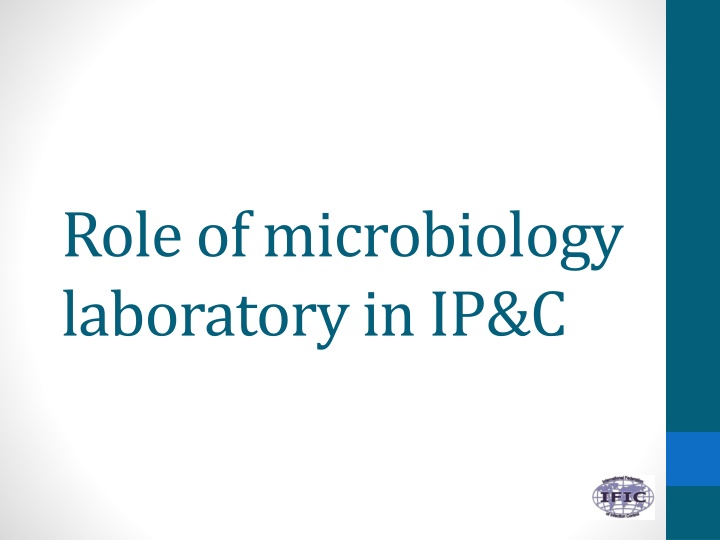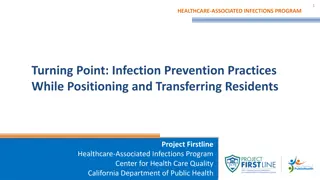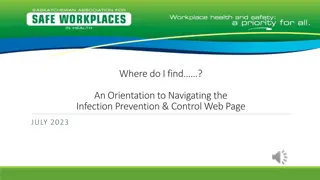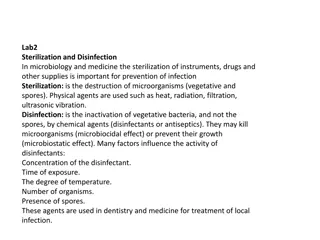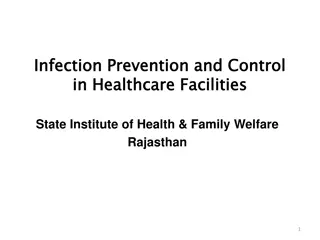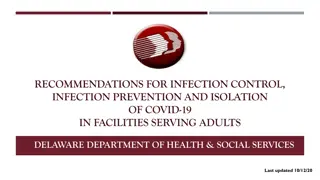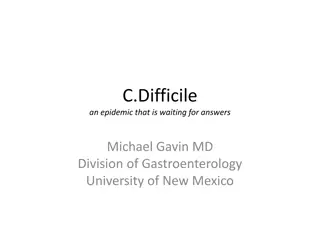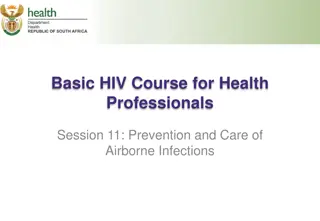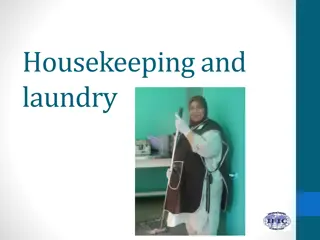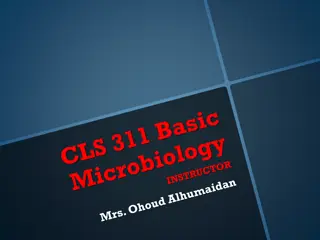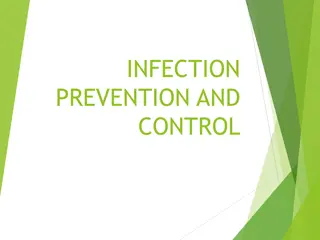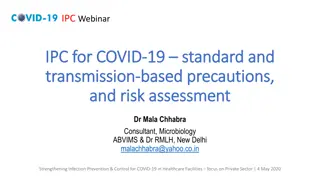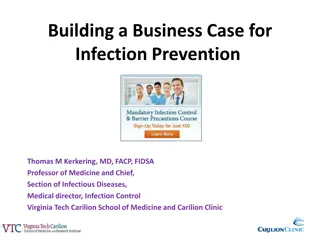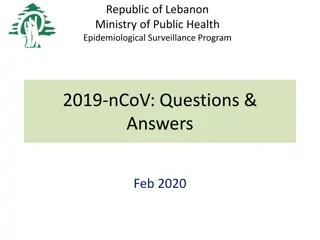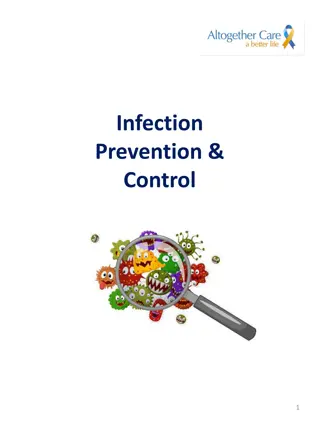Role of Microbiology Lab in Infection Prevention and Control
Microbiology laboratory plays a crucial role in managing patients with infections, identifying important microorganisms causing HAIs, and preventing/control of infections. Understanding basic properties of microorganisms, their transmission modes, and the pathogenesis of infections is essential in healthcare settings.
Download Presentation

Please find below an Image/Link to download the presentation.
The content on the website is provided AS IS for your information and personal use only. It may not be sold, licensed, or shared on other websites without obtaining consent from the author.If you encounter any issues during the download, it is possible that the publisher has removed the file from their server.
You are allowed to download the files provided on this website for personal or commercial use, subject to the condition that they are used lawfully. All files are the property of their respective owners.
The content on the website is provided AS IS for your information and personal use only. It may not be sold, licensed, or shared on other websites without obtaining consent from the author.
E N D
Presentation Transcript
Role of microbiology laboratory in IP&C
Objectives August 23, 2013 1. Describe the basic properties of microorganisms, including their natural habitat and mode of transmission. 2. List the most important "alert" microorganisms causing HAIs. 3. Explain the role of microbiology laboratory in managing patients with infections. 4. Explain the four roles of the microbiology laboratory in the prevention and control of HAIs. 2
Time involved 60 minutes August 23, 2013 3
Basic microbiology Microorganisms are agents of infectious diseases They are ubiquitous in nature and in/on human body Most microorganisms harmless for humans Some can cause disease Microorganisms are divided into Bacteria Fungi Viruses Prions Parasites August 23, 2013 4
Pathogenesis of infection When microbes find a new host and start to multiply called colonisation A balance can develop between colonised microbes and humans will lead to so called normal flora If microbe causes disease called an infection If source of microbe is patient s own flora called an endogenous infection If source of microbe is flora from outside the patient s body called exogenous infection August 23, 2013 5
Microorganism Transmission Spread to a new host from another human, animal or environment Transmission direct or indirect Pathways of transmission could be Contact hands surgical instruments Contaminated surfaces or items (indirect contact) Air Water Food Live vectors, e.g., mosquitos August 23, 2013 6
Bacteria Smallest microorganisms with all functions of life Multiply by simple division Form visible colonies on a solid surface Genetic material transferred vertically and horizontally between different bacteria Some can form spores The most resistant form of life August 23, 2013 7
Bacteria Acinetobacter baumannii Bordetella pertussis Campylobacter jejuni, C. coli Clostridium difficile Habitat Moist skin, GI tract NP mucosa GI tract GI tract August 23, 2013 Survival on dry surfaces 3 days 5 months 3-5 days Up to 6 days Spores 5 months Spread in HC Contact Droplets Faecal-oral, water, food Faecal-oral; contact HAIs UTI, sepsis, meningitis, pneumonia Pertussis Diarrhoea CDI Specimens Urine, blood, CSF, sputum, aspirates NP swab Stool Stool Prevention Clean environment, instruments, hands Isolation Safe food and water, clean hands Clean environment,, hands, use of antibiotics 8
Bacteria Clostridium tetani Coagulase negative staphylococci (CNS) C. diphtheriae Enterococcus species August 23, 2013 Habitat Environment Skin, mucous membranes NP GI tract, GU tract Survival on dry surfaces 7 days 6 months 5 days 4 months Spread in HC Entering umbilical cord Contact Droplet, contact Contact, endogenous HAIs Tetanus Various Diphtheria UTI, sepsis Specimens Various NP swab Urine, blood Prevention Sterilisation of instruments Clean environment, instruments, hands Isolation, vaccination Clean environment, hands, use of cephalosporins 9
Bacteria Enterobacter species Escherichia coli Helicobacter Klebsiella pneumoniae pylori Habitat Environment, GI tract GI, GU tract Gastric mucosa Environment, GI tract August 23, 2013 Survival on dry surfaces 5-49 days 1.5 hours 16 months Less than 90 minutes 2 hours more than 30 months Spread in HC Contact, food Faecal-oral, contact, endogenous GI endoscopes Contact, endogenous HAIs UTI, sepsis, wound infection UTI, sepsis, neonatal meningitis Gastritis UTI, sepsis, pneumonia Specimens Various Various Various Various Prevention Clean environment, equipment, hands Clean hands, use of cephalosporins Properly disinfected GI endoscopes Clean hands, use of cephalosporins 10
Bacteria Legionella pneumophila Listeria monocytogenes M. tuberculosis Neisseria meningitidis Habitat Water GI tract, soil Respiratory tract NP August 23, 2013 Survival on dry surfaces 1 day - months 1 day 4 months Spread in HC Aerosols Contaminated food/equipment ; perinatal Airborne Droplets HAIs Legionnaire s disease Meningitis, bacteremia Tuberculosis Meningitis Specimens Sputum, blood for serology Blood, CSF Sputum CSF Prevention Hyperchlorinati on of water or heating to at least 55 C Safe food, clean equipment in nurseries Isolation Isolation, vaccination 11
Bacteria Proteus species Pseudomonas aeruginosa Salmonella species Salmonella typhi Habitat GI tract GI tract, humid areas GI tract GI tract August 23, 2013 Survival on dry surfaces 1-2 days 6 hours to 16 months 1 day 10 months 4.2 years Faecal-oral Spread in HC Contact, endogenous Contact Faecal-oral HAIs UTI, sepsis Various Diarrhoea, sepsis Typhoid fever Specimens Urine, blood Various Stool, blood Stool, blood Prevention Clean environment, equipment, hands Clean, dry environment, disinfected/sterili sed equipment; clean hands, use of antibiotics Safe food, water, clean hands Safe food, water, clean hands 12
Bacteria Salmonella typhimurium Serratia marcescens Shigella species S. aureus Habitat GI tract GI tract, humid areas GI tract Skin, mucous membranes August 23, 2013 Survival on dry surfaces 10 months 4.2 years 3 days 2 months 2 days 5 months 7 days - 7 months Spread in HC Faecal-oral Contact, IV fluids Faecal-oral Contact, droplets, equipment, endogenous HAIs Diarrhoea, sepsis Sepsis, wound infection Diarrhoea Various Specimens Stool, blood Blood, wound exudate Stool Various Prevention Safe food, water, clean hands Clean environment, equipment, hands Safe food, water, clean hands Clean hands, environment; use of antibiotics 13
Bacteria S. agalactiae (Group B streptococcus) S. pyogenes (Group A streptococcus) Vibrio cholerae Yersinia enterocolitica Habitat Birth canal Oropharyngeal mucosa GI tract GI tract August 23, 2013 Survival on dry surfaces 3 days-6.5 months 1 7 days Spread in HC Contact, Intrapartum Droplet, contact, endogenous Faecal-oral Blood transfusion HAIs Sepsis and meningitis of newborn Pharyngitis, surgical wound infection Cholera Bacteremia Specimens Blood, CSF Oropharyngeal swab, wound exudate Stool Blood, stool Prevention Antibiotic prophylaxis during delivery; clean hands Clean hands, masks in operating room Safe water and food Safe blood products 14
Fungi Unicellular (yeasts) or multicellular (moulds) Reproduce asexually (conidia) and sexually (spores*) Ubiquitous in nature some are parts of human normal flora Most opportunistic pathogens Cause severe infections in immunocompromised host August 23, 2013 * Fungal spores are not resistant to environmental factors like bacterial spores! 15
Fungi Candida albicans (yeast) Candida glabrata (yeast) Candida parapsilosis (yeast) Habitat Environment, mucosa Environment, mucosa Environment, mucosa August 23, 2013 Survival on dry surfaces 1-120 days 120-150 days 14 days Spread in HC Contact, endogenous Contact, endogenous Contact, endogenous HAIs Various Various Various Specimens Various Various Various Prevention Clean hands, equipment Clean hands, equipment Clean hands, equipment 16
Fungi Aspergillus species (mould) Mucor (mould) Rhizopus (mould) Habitat Environment, air Environment Environment August 23, 2013 Survival on dry surfaces Conidia and spores are resistant Conidia and spores are resistant Conidia and spores are resistant Spread in HC Inhalation, (contact) Inhalation Inhalation HAIs Various Various Various Specimens Various Various Various Prevention Safe water, air, reverse/protective isolation Safe food, reverse/protective isolation Safe food, reverse/protective isolation 17
Viruses -1 Smallest infectious agents Require living cell for reproduction bacterial, plant or animal Consist of either DNA or RNA and a protein coat Some have also an outside lipid envelope August 23, 2013 18
Viruses -2 Entering the cell, virus makes the cell synthesise its nucleic acid and proteins The cell is severely damaged or destroyed and infectious disease develops August 23, 2013 19
Virus Coronavirus, including SARS Coxackie B virus Cytomegalovirus Adenovirus Habitat Water, fomites, environment Humans Humans Humans August 23, 2013 3 hours SARS virus: 72- 96 hours >2 weeks 8 hours Survival on dry surfaces 7 days 3 months Spread in HC Contact Droplet Faecal-oral; contact Blood products, tissue and organs HAIs Eye, respiratory infections Respiratory infections Generalised disease of newborn Various Specimens Serum sample Serum sample Serum sample Serum sample Prevention Individual eye drops Isolation, clean hands, environment Clean hands, environment Safe blood products, tissues/ organs for transplantation 20
Virus Human immunodeficiency virus Influenza virus Norovirus Respiratory syncytial virus Habitat Humans Humans Humans Humans August 23, 2013 Survival on dry surfaces >7 days 1-2 days 8 hours 7 days Up to 6 hours Spread in HC Blood, body fluids, tissue, organs for transplant Droplets, contact Faecal-oral, contact Droplets, contact HAIs Acquired immune deficiency syndrome Influenza Diarrhoea Acute respiratory infections Specimens Serum sample Serum sample Serum sample NP exudate Prevention Safe blood products and tissues/organs for transplant Isolation, vaccination Clean hands, environment, safe food Isolation, clean hands, environment 21
Virus Rotavirus Rubula virus (mumps) Rubivirus (rubella) Habitat Humans Humans Humans August 23, 2013 Survival on dry surfaces 6-60 days Spread in HC Faecal-oral, contact Droplets Droplets HAIs Diarrhoea Mumps (parotitis) Rubella (German measles) Specimens Stool Serum sample Serum sample Prevention Clean hands, environment Isolation, vaccination Isolation, vaccination 22
Virus Morbillivirus (measles) Varicella-zoster virus Habitat Humans Humans August 23, 2013 Survival on dry surfaces Spread in HC Droplets Droplets, close contact HAIs Measles Varicella Specimens Serum sample Serum sample Prevention Isolation, vaccination Isolation, vaccination 23
Prions Prions are proteinaceous particles Do not contain any nucleic acid Connected to several severe neurologic diseases Highly resistant to usual disinfection and sterilisation methods Possibility of iatrogenic transmission Through transplantation Through instruments contaminated with brain tissue, dura or cerebrospinal fluid of infected person August 23, 2013 24
Parasites Include protozoa Unicellular microorganisms Live in nature or in human or animal host Some of them cause infections Multicellular parasites Worms, that can also cause infections (often called infestations) Cause frequent diseases in humans, especially in warm climates (e.g., malaria, shistosomiasis) Not often the cause of HAI August 23, 2013 25
Parasite Cryptosporidium (protozoa) Plasmodium species (protozoa) Trichomonas vaginalis (protozoa) Enterobius vermicularis (helminth) Habitat Liver, erythrocytes Vaginal mucosa Intestinal tract August 23, 2013 Survival on dry surfaces 2 hours on dry surface Several hours in humid environment Eggs: at least 1 year Spread in HC Mosquito- borne; infected blood Contaminated equipment in gynaecology Faecal-oral HAIs Malaria Vaginal infection Enterobiasis Specimens Blood Vaginal discharge Perianal tape Prevention Safe blood products Disinfected/ sterilised equipment in gynaecology Clean environment, clean hands 26
Role of microbiology laboratory: Introduction August 23, 2013 The diagnosis of infections performed by the laboratory has two important functions Clinical Diagnosis of infection in an individual patient for everyday management of infections Epidemiological Support for infection prevention and control in searching for source and route of transmission of HAI 27
Minimal requirements for microbiology services -1 August 23, 2013 1. Set up inside the facility If not possible, negotiate a contract for diagnostic microbiology with the nearest laboratory 2. Available every day, including Sundays and holidays Ideally on a 24-hour basis 3. Able to examine blood, cerebrospinal fluid, urine, stool, wound exudate or swab, respiratory secretions, and perform basic serological tests (HIV, HBV, HCV) 28
Minimal Requirements for microbiology services -2 August 23, 2013 4. Identify common bacteria and fungi to species level 5. Perform susceptibility testing using disc- diffusion methodology 6. Perform basic phenotyping Serotyping Salmonellae, Shigellae, P. aeruginosa, N. meningitidis Biotyping S. typhi 29
Clinical role: Diagnosis of infection Diagnosis should be rapid and accurate to the species level wherever possible Classical bacteriological methods Direct smear Culture Antigen detection Sensitivity testing Antibody detection Not very useful in the early stages of infection Molecular methods Rarely used in routine work for the diagnosis of bacterial HAI August 23, 2013 30
Role in prevention and control of healthcare associated infections August 23, 2013 Outbreak investigation Surveillance of HAIs Alert microorganisms reports Designing antibiotic policy 31
Outbreak Investigation To determine the cause of a single-source outbreak the causative agent must be defined Then microbiology laboratory determines if two or more isolated strains are same or different August 23, 2013 32
Additional tests during an outbreak August 23, 2013 Sometimes the IP&C Team requires additional data to clarify endemic or epidemic situations Microbiological tests may be required Blood products Environmental surfaces Disinfectants and antiseptics Air Water Hands of personnel Anterior nares of personnel 33
HAI surveillance The microbiology laboratory should produce routine reports of bacterial isolates Allows the IPC& Team to make graphs for specific pathogens, wards, and groups of patients A baseline incidence can be established Any new isolate can then be compared with this incidence If the laboratory is computerised, these data can be made readily available August 23, 2013 34
Alert organism reports Identify possible agreed alert microorganisms Methicillin-resistant Staphylococcus aureus (MRSA) Vancomycin-intermediate S.aureus (VISA) Vancomycin-resistant enterococci (VRE) MDR Pseudomonas aeruginosa MDR Acinetobacter baumannii MDR Mycobacterium tuberculosis ESBL enterobacteria Clostridium difficile August 23, 2013 35
Antibiotic policy Regular reporting of changing resistance patterns Newsletters Specialty specific data Restricted antibiotic reporting Routinely only first line antibiotics Reserve antibiotics only if pathogen is resistant to first line antibiotics August 23, 2013 36
Antibiotic stewardship August 23, 2013 Role of Clinical Microbiologist/ID specialist Provide leadership to antimicrobial team Antibiotic ward rounds Interpretation of patient specific data to optimise treatment culture & sensitivity Active surveillance/ awareness Screening for carriage of resistant bacteria Molecular detection and typing 37
Interpretation of Microbiology Data August 23, 2013 Microbiologists interpret microbiological data for IP&C staff Results of isolation, identification, susceptibility tests, typing Ideally should be medical doctor specialistt If this is not possible, then a properly educated scientist is required 38
Role in education Infection prevention staff how to interpret microbiological reports/charts Other healthcare workers specimen collection and transport, interpretation of reports and sensitivity tests Students (medical and nursing) basic microbiology August 23, 2013 39
Key points -1 Microbes are infectious agents not visible to the naked eye Widespread in nature and some cause human disease Diagnosis of infection by the microbiology laboratory has two important functions Clinical Epidemiological The laboratory should determine the most frequent microbes causing infections, including HAI pathogens August 23, 2013 40
Key points -2 The laboratory should perform basic typing of microorganisms The laboratory should produce routine reports for IP&C personnel To make incidence graphs for specific pathogens, wards, and groups of patients Medical microbiologists interpret microbiological findings for IP&C personnel and act together with clinical and nursing colleagues in prevention of HAI August 23, 2013 41
References August 23, 2013 Diekema DJ, et al. Infection Control Epidemiology and Microbiology Laboratory. In Manual of Clinical Microbiology, 8th Ed., Murray PR, Editor in Chief, ASM Press, Washington, DC, 2003:129-138 Peterson LR, et al. Role of clinical microbiology laboratory in the management and control of infectious diseases and the delivery of health care. Clin Infect Dis 2001; 32:605-611 Gill VJ, et al. The clinician and the Microbiology Laboratory. In: Mandell, Douglas and Bennett s Principles and Practice of Infectious Diseases, 6th ed., Mandell GL, Bennett JE, Dolin R, Editors, Elsevier, Philadelphia, 2005:203-241 42
References August 23, 2013 Stratton CW IV, Greene JN. Role of the Microbiology Laboratory in Hospital Epidemiology and Infection Control. In: Hospital Epidemiology and Infection Control, 3rd Ed., Mayhall CG, Editor, Lippincott, Williams & Wilkins, Philadelphia, 2004:1809-1825 Poutanen SM, Tompkins LS. Molecular Methods in Nosocomial Epidemiology. In: Prevention and Control of Nosocomial Infections, 4th Ed., Wenzel RP, Editor, Lippincott, Williams & Wilkins, Philadelphia, 2003: 481- 499 43
Quiz 1. Microorganisms that can cause disease in humans cannot live in the inanimate environment. T/F Genetic material in bacteria can be transmitted not only vertically, but also horizontally. T/F For the role of microbiology laboratory in HAI surveillance, which of the following laboratory characteristics is not necessary: a. Produce routine periodic reports of isolated microbes b. Make baseline incidence graphs c. Have a physician as a microbiologist d. Have a vigorous quality assurance program August 23, 2013 2. 3. 44
International Federation of Infection Control IFIC s mission is to facilitate international networking in order to improve the prevention and control of healthcare associated infections worldwide. It is an umbrella organisation of societies and associations of healthcare professionals in infection control and related fields across the globe . The goal of IFIC is to minimise the risk of infection within healthcare settings through development of a network of infection control organisations for communication, consensus building, education and sharing expertise. For more information go to http://theific.org/ December 1, 2013 45
